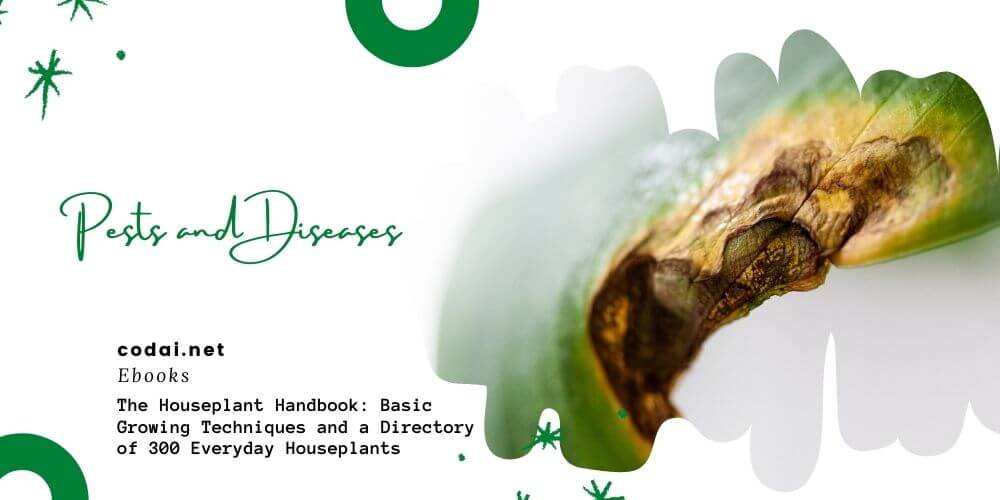[Ebook Việt hóa] The Houseplant Handbook: Basic Growing Techniques and a Directory of 300 Everyday Houseplants, Sâu - Bệnh
[Ebook Việt Hoá] 300 Everyday Houseplants: Houseplant Problems (Các vấn đề thường gặp đối với cây cảnh trồng trong nhà)
- Nguồn: [Ebook] The Houseplant Handbook: Basic Growing Techniques and a Directory of 300 Everyday Houseplants – David Squire
- Biên tập: Dũng Cá Xinh (Tháng 02/2022)
- Dịch: Team Codai.net
English
Houseplant Problems (Các vấn đề thường gặp đối với cây cảnh trồng trong nhà)
Few plants can escape from pests and diseases or cultural problems (often known as physiological disorders), such as leaves and flower buds falling off. It is much easier to prevent attack by pests and diseases than to eliminate them from badly affected plants. Here are some prevention tips.
- Buy plants from reputable sources.
- Inspect plants before buying.
- Regularly check for infestations.
- Never use garden soil instead of potting compost as it may contain weed seeds, pests, or diseases.
- Avoid leaving dead flowers and leaves around plants.
- Check root balls for soil pests when plants are being repotted.
- Never use infected plants as propagation material.
The chemicals permitted by legislation vary from country to country and state to state, so if prevention fails, check with your local nursery or garden center about the most suitable insecticide to use for your specific problem.
Pests

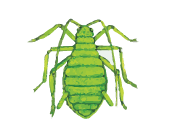
- Aphids: also known as greenfly, aphis, and aphides, they are the main pests of houseplants. These small, usually green, sap-sucking insects infest flowers, shoot tips, and soft leaves, sucking sap and causing mottling and distortion. They also excrete honeydew, which attracts ants and encourages the presence of a fungal disease called sooty mold.
- Control: spray with a suitable insecticide as soon as aphids are seen. Repeat every 10–14 days throughout summer.


- Cyclamen mites: these infest a wide range of plants, including cyclamen, pelargoniums, saintpaulias (African Violets) and impatiens (Busy Lizzies). They are minute, eight-legged, spider-like creatures that cluster on the undersides of leaves. They suck sap, causing leaves to crinkle and darken. Flowering is shortened and buds become distorted and may fall off.
- Control: remove and burn seriously infested leaves and flowers. Spray with an acaricide. Destroy badly infected plants to prevent the mites from spreading.

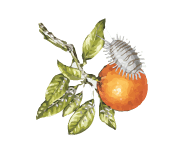
- Mealy bugs: white, waxy, woodlice-like creatures that live in groups and especially infest ferns, palms, azaleas, and hippeastrums. They suck sap, causing distortion, loss of vigor, and yellowing of leaves. They excrete honeydew, which encourages the presence of ants and sooty mold.
- Control: wipe off light infestations with cotton swabs dipped into methylated spirits (rubbing alcohol). Spray with a suitable insecticide or burn seriously infected plants.

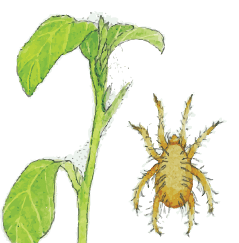
- Red spider mites: also known as greenhouse red spider mites, they are spider-like, minute, usually red, and have eight legs. They suck leaves, causing mottling and, if the infestation is severe, webs. These are unsightly, reduce air circulation around the plant, and make eradication difficult.
- Control: mist-spray daily with clean water (but avoid spraying flowers or soft leaves) and spray with a suitable acaricide.


- Scale insects: swollen, waxy-brown discs, usually static, under which female scale insects produce their young.
- Control: young scale insects can be wiped away with a cotton swab dipped in methylated spirits (rubbing alcohol). Established colonies are difficult to eradicate, and badly contaminated plants are best burned.


- Thrips: these tiny, dark brown, fly-like insects jump from one plant to another. They pierce leaves and flowers, sucking sap and causing silvery mottling and streaking. Undersides of leaves develop small globules of a red liquid that eventually turns black.
- Control: spray several times with a suitable insecticide or burn seriously infected plants. Keep the compost moist, because dryness intensifies the damage caused by these insects.

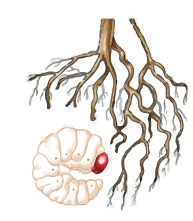
- Vine weevils: serious pests in the adult form, when young, and as larvae. Adults are beetle-like, with a short snout. They chew all parts of plants. The larvae—fat, legless, and creamy white, with brown heads—inhabit compost and chew roots.
- Control: immediately water the compost with suitable insecticide and spray the leaves. Destroy badly infected plants.

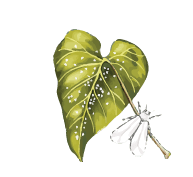
- Whitefly: small, moth-like white insects that flutter from one plant to another when disturbed. They have a mealy or powder-like covering and are mostly found on the undersides of leaves, sucking sap, causing distortion, and excreting honeydew, which encourages the presence of ants and sooty mold.
- Control: eradication is not easy; several sprayings at five-day intervals with a suitable insecticide are essential.
Diseases

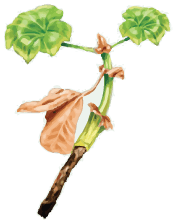
- Black leg: a disease mainly of cuttings, especially of pelargoniums; the bases become black and soft.
- Control: this is encouraged by cold, wet, airless compost, so ensure compost is well aerated when taking cuttings. If cuttings are infected, they are best removed and destroyed; for rare or unusual varieties, remove cuttings, cut off the blackened area, and reinsert the base in fresh compost.

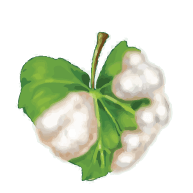
- Botrytis: also known as gray mold, it attacks soft parts of plants, such as flowers, shoots, and young leaves, covering them with a gray, furry mold.
- Control: cut off and destroy infected parts. Spray infected plants with a suitable fungicide. Remove dead flowers to discourage spreading. Avoid damp, still air and excessive water.

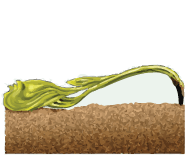
- Damping off: attacks seedlings soon after they germinate, causing them to turn black and collapse.
- Control: sow seeds thinly in well-drained compost and place in a warm and well-aerated location. Avoid excessively watering the compost.

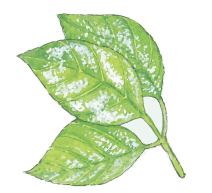
- Powdery mildew: fungal disease that produces a white, powdery coating. It usually appears in spring and summer, infecting leaves, flowers, and stems.
- Control: remove badly infected leaves, stems, and flowers; increase ventilation and keep the atmosphere dry.

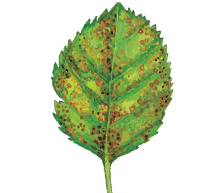
- Rusts: complex diseases that are more problematic in sunrooms and conservatories than indoors. They produce raised rings of brown or black spots. Plants become unsightly and lose their vigor.
- Control: remove and burn infected plants and increase ventilation. Do not propagate from infected plants.


- Sooty mold: black, fungal disease that grows on leaves, stems, and flowers covered with honeydew. At first it appears in small clusters, but later covers the entire surface.
- Control: spray with a suitable insecticide against sap-sucking insects. Use a damp cloth to remove the black growth from leaves. Flowers are best cut off.

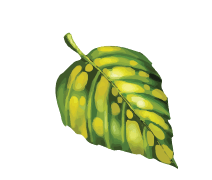
- Viruses: microscopic particles that invade plants (and animals), causing disorders in the tissue but seldom killing the host immediately.
- Control: regularly spray with a suitable insecticide against sap-sucking insects (which probably introduced the problem to your plants) and burn badly infected plants.
Nonchemical Control of Pests and Diseases
Apart from growing plants healthily, with adequate moisture, food, and circulation of air, there are other ways to keep them healthy and to ward off pests and diseases.
Cultural Problems
Also known as physiological disorders, these are not caused by pests or diseases but by environmental problems.
Wilting: there are several causes, including too much water, too little water, and the result of soil pests that eat and destroy roots. Usually, plants wilt because they are short of water; if the compost is dry, water the plant several times. Alternatively, stand the plant, in its pot, in a bowl of water. Later, remove and allow excess water to drain. If a plant wilts and the compost is exceptionally wet, remove the pot and dry the root-ball.
Leaves fall off: occasionally, leaves fall off as a result of factors such as dry or wet soil, pests and disease, and cultural influences, including a sudden drop in temperature. Reposition the plant and keep it in an even, warm temperature away from drafts. Leaves that become yellow and gradually drop off are the result of excessive watering or inadequate feeding.
Flower buds fall off: this may happen if the plant is in a draft or a dry atmosphere or has received a sudden chill. Buds often drop off if a plant is severely knocked.
Damaged leaf surfaces: lack of water may make the edges of leaves become crisp and brown, but straw-colored patches on leaves, especially soft and hairy ones, are the result of water splashing on the surface, which is then burnt by strong sunlight.


Applying Chemicals
There are several ways in which insecticides and fungicides can be applied to plants.
Safety Tips
Tiếng Việt
Đang cập nhật
